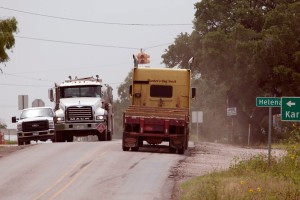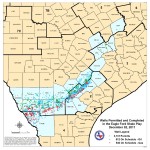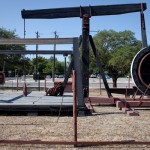While Profits Are Up in the Eagle Ford Shale, So is Road Damage

Photo courtesy Texas Department of Transportation.
Truck traffic on FM 81 in the Eagle Ford Shale formation area.
The Eagle Ford shale’s development in Texas is growing stronger from increasing production, as crude oil growth overtakes natural gas production. And with more production comes more profitability, according to a new report by GlobalData, a business research company.
The shale’s liquid production has increased nearly sixfold, going from 10.8 million barrels of oil in 2010 to 57.5 million barrels in 2011. With almost 6,000 drilling permits distributed since the beginning of 2011, the total gross production from the Eagle Ford shale is expected to reach 207.3 million barrels in 2012, and stabilize at 1,386.3 million barrels in 2020, according to the report. But with that growth comes a price.
Drilling trucks are doing their damage on Texas roads, especially on highways, bridges, or other roads not designed for heavy loads. The Texas Department of Transportation said Monday that damage from those trucks is at two billion dollars.
According to a report released by DeWitt County Judge Daryl Fowler, whose county sits in the middle of the shale, tax revenues from drilling will not be enough to fix the roads. The report says that DeWitt County received $7.2 million in property taxes for the fiscal year ending in September, but will need as much as $342 million to replace or repair 394 miles of roads.
“Right now, taxes and donations are the only two viable options available to fix county roads,
which may require up to $80,000 per mile to repair and up to $1,900,000 per mile to rebuild,” Fowler said in a statement accompanying the report. “Austin may be waiting for a rainy day, but you could describe our situation as similar to being in the middle of a monsoon; and it’s high time to do something about it.”
Read the full DeWitt County Commissioners report on road damage in the Eagle Ford shale:

